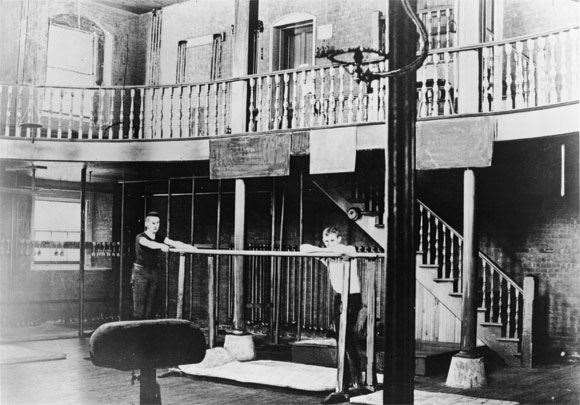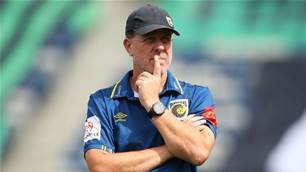How he came to know about it is unclear, but certain aspects of the game, called “duck on a rock”, or “duck and run”, stayed with him and informed his invention of basketball.
 Image : Getty Images
Image : Getty ImagesAs a kid brought up on a farm in Canada in the 1860s, James Naismith (born in ‘61) would spend his days with friends playing hide-and-seek, catch, and a strange game resurrected from medieval times. How he came to know about it is unclear, but certain aspects of the game, called “duck on a rock”, or “duck and run”, stayed with him and informed his invention of basketball.
The game involved one kid guarding a large stone, mounted on a stump or a boulder, called a “drake stone” (presumably derived from the English term for skipping stones, “ducks and drakes”), while other kids tried to knock it over by throwing smaller stones at it, then retrieve their rocks without being tagged by the guard. If caught, it was their turn to guard the rock. Naismith worked out that straight, hard throws weren’t as effective as gentle lobs ... he became proficient at this obscure game.
In his time at McGill University, Naismith, though lightly built, was a distinguished athlete, earning numerous awards for gymnastics and representing the college at lacrosse, football, soccer and athletics. He’s credited with introducing the helmet into the game of “Canadian Football”.
When Naismith left Montreal for Springfield, Massachusetts for a post as a physical education teacher, he was faced with an immediate challenge: unruly classes of boys who became irritable and distracted during the freezing New England winters. The school was a YMCA training school, and Dr Luther Gulick, head of YMCA physical education, entreated Naismith to invent an indoor sport to help students expend energy and get fit for the athletics season. Gulick specified only that the game be “fair and not rough”.
Getting straight to work, Naismith was guided by one important principle: minimal physical contact. Noting the most popular games played at the time, Naismith decided that a large, soft ball, round like a soccer ball, was the least dangerous object for his new game. He decided to make
his new game one of passing, to minimise the possibility of physical contact with opposing players, which, he concluded, mainly occurred in sport while players were in possession of a ball. The goal in his new game was to be undefendable. That way, no one was ever going to be hurt trying to guard it from opposition attacks. Therefore, he set it high above the heads of the players. The only way to score would be to master the lobbed shot, just as he mastered it in his medieval barnyard game!
Once he developed these broad principles, Naismith set about devising the rules for the game he dubbed “Basket Ball”. He came up with 13. The first game didn’t feature the modern “hoop”, but rather a pair of peach baskets. There were nine to a side, the ball only to be progressed up court via passing (therefore the “dribble” was yet to be a feature). Many of the broad principles of the modern game were in place during that first game, held in December 1891, and recorded in detail in a handwritten report by Naismith.
Though the players were initially unenth-usiastic in that first game, they began to enjoy it as the rules became more clear and their play more fluent. The game was an instant hit, and evolved quickly and naturally into the modern version. By the next year the game was played enthusiastically on campus, and the school newspaper heralded Basket Ball in an article titled A New Game. By 1893, Basket Ball was introduced internationally by the YMCA.
Naismith moved to the University of Kansas to pursue medical studies, and in 1898, the University began its own Basket Ball program. The YMCA program, and later, the college system, helped spread the game’s fame across the US, and one of Naismith’s proteges at Kansas, Forrest “Phog” Allen (who coached despite Naismith’s alleged attempts to discourage him), would become known as the “father of basketball coaching”.
At first, even as the new game took off, Naismith considered his sport a curiosity; a physical activity designed only to supplement other sports. He rejected the idea of the sport being called “Naismith Ball”, and wanted no part of self-promotion of any kind. Instead, he pursued his career as an academic and author. However, as time went on, Naismith proudly witnessed the spread of the game worldwide, and, thanks to the efforts of Phog Allen, he attended the 1936 Olympics in Berlin to witness its introduction as a demonstration sport.
During those Games, he was named honorary head of the new International Basketball Federation, and publicly stated that watching the game played by so many nations was the “greatest compensation” he could’ve had for his involvement in its development.
Naismith died in 1939 of a brain hemorrhage, and his masterwork, titled Basketball ‒ Its Origins And Development, was published two years later.
‒ Robert Drane
Related Articles

Champion A-League coach set to join Premier League giants

Emerging Socceroos star set to sign for MLS club













